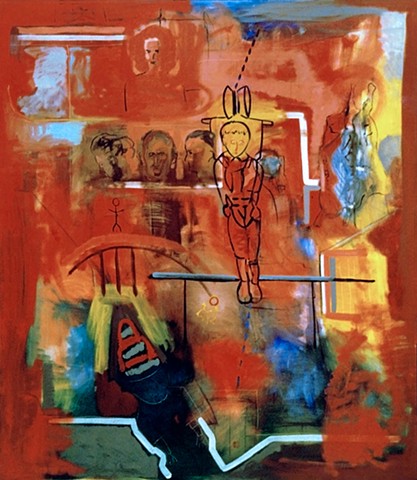Chair-Lift by Gerry Gleason. 30th Anniversary of Berlin Wall coming down.
Gerry Gleason Jan 1989.
Collection-
Schloss Friedenstein Gotha Germany.
Revolution number 89
Gerry Gleason's "Chairlift" overcomes walls
Thirty years ago the Wall fell in Germany, but it remains an issue. The
wall in people's minds, which often seems tougher than concrete, the
walls in other countries, which are still standing or just being planned
again.
Here we want to tell of a painting by Gerry Gleason from Belfast. There,
too, one lives with a wall that is euphemistically called the Line of
Peace. Only in the last years it was raised in places up to twelve
meters. There is also the Good Friday Agreement of 1998, which has
satisfied the conflicts and outbreaks of violence that have been
smouldering since the 1960s with thousands of deaths and has transformed
them into the struggle for a political solution. A world which is by no
means intact and which could be thrown out of joint again by the
dragging Brexit.
On Gerry Gleason's first visit to Germany in 1989, in West Berlin, a
cold concrete wall divided the city. Gleason recalls: "I just came from
Belfast, from this situation of confinement and paranoid pressure under
violent conditions. With West Berlin I had always thought of West
Germany, and I was scared when I discovered that the plane had brought
me to an island. So suddenly I ended up in a situation similar to home."
The painter left the "Golden Cage" for a short trip to East Berlin. When
checking at the border, the formalities and controls he had to endure,
the parallels between the divided Berlin and Germany and the Protestant
and Catholic parts of Belfast, separated by the line of peace, the
politically separated north of Ireland, forced themselves inevitably and
as in a nightmare.
Life in a city that was shaken by terror in the 70s and 80s and remained
in a permanent state of emergency. Without tangible reasons to hope for
a normal, peaceful everyday life. Until the Good Friday Agreement, with
which terror lost its support among the population.
The constant pressure makes people hard, but it also sensitizes them. "A
wall," according to the artist at the time, "can keep people in prison,
but not their thinking, their imagination.
In the museum at Checkpoint Charlie, Gleason had seen a photograph of a
boy who had fled the GDR with his parents in a hot-air balloon. This
scene buried itself in the painter's memory. Back in Belfast, Gleason
relived his journey - artistically. He painted a picture whose central
figure is that little boy. "As a child, I dreamed - like many others
perhaps - of flying, of stretching out my arms and ascending into the
sky," the painter told me. "I remembered it when I saw the boy overcome
the barrier. For Gleason, this story became a symbol of the flight over
the history of the Wall, the power of confidence, the invincibility of
fantasy and utopia.
"But I also wonder what freedom of choice the child actually had in this
situation. None. And what would happen if the walls fell? The experience
is deep and not easily bribed. It turns out that it is very difficult to
overcome the wall of thought."
After the Wall came down, I met Gerry Gleason personally, who was
exhibited by gallery owner Jürgen Schneider in Berlin Prenzlauer Berg.
And a few years later he succeeded in donating his large-format oil
painting of the escape in a balloon to the Gothaer Museum Schloß
Friedenstein, near the former dividing line between East and West. As a
sign of hope, but also of remembrance of the Wall and as a reminder not
to forget the remaining barriers. After all, in Belfast in 1992
splitting, spatial separation by walls, concrete and barbed wire were
still bitter reality. Meanwhile in Germany walls were strengthened in
thinking. Or in the former Yugoslavia a gruelling and gruesome war did
not want to end. So the problems in Belfast resembled a microcosm in the
macrocosm world.
In Gerry Gleason's painting "Chairlift (Berlin to Belfast) is a bridge
connecting people, past and future. At the end a light shines,
schematically still, but still visible. The people in the subway who
pass through the ghost stations between West and West under the East
hardly notice each other. "Gleason, who sees in the encounter, in the
approaching to each other an important force, also to overcome barriers
between people, their religion, their nationality.
The episodic basis of the painting points beyond itself. Gleason's
painting is a signal of hope and confidence, which is also reflected in
the bright colours and transparency of red and blue. "I try to look
beyond the barriers of the present into the future, to deal with the
past and to understand it as part of history, as necessary for the future.
Beate Lemcke.
Art Critic Berlin November 2019.
